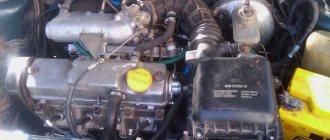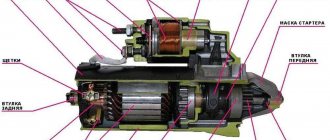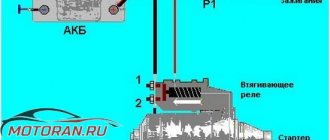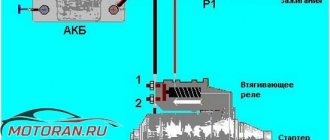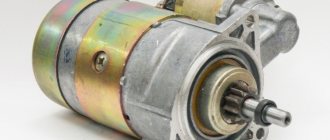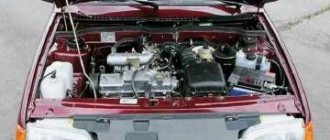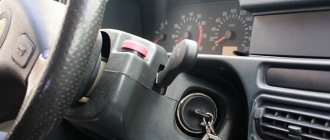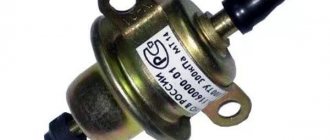23.06.2014
Engine assembly
Let's look at the reasons why the engine won't start. What are the solutions and what should a person who finds himself in this situation do? We will talk about Samaras with an injection engine, since there are few carburetor ones left today.
If we are talking about the cold season - you did not start in winter, then there are several nuances regarding the engine starting algorithm. Perhaps your candles have flooded or something else. To study this issue more specifically, read the article: How to start a car in cold weather? Where the algorithm is described and, again, possible causes of the malfunction.
Now we will talk more deeply about the technical part, since “winter factors” are no longer needed.
We will describe the problems in the order of the actions taken: that is, starting from the inserted key and ending with the operation of the engine.
The starter works, the engine turns, but the car does not start
So, the starter, like the engine, the pistons move, but the engine still won’t start. There is already a problem here, most likely in the fuel-air mixture, perhaps the marks have come off, etc.
Before you sin on this, the first thing you need to pay attention to is the crankshaft sensors:
DPKV - if it malfunctions, it is very difficult to start the engine, and once it is running, it runs unevenly, intermittently, and the power drops noticeably.
Next you should pay attention to the labels:
- Mark on the timing camshaft gear (photo).
- Markings on the flywheel under the thermostat (photo).
If the marks do not match, most likely the belt has simply slipped by one tooth. The camshaft gear itself may be worn. It needs to be adjusted and installed correctly!
Next we will talk about the air-fuel mixture.
I warn you in advance that the easiest way is to do computer diagnostics of the engine or look at the errors on the on-board computer.
The air-fuel mixture is the combination of air, gasoline, and the spark needed to ignite it.
Air supply
As a rule, a malfunction in the air supply should not affect the engine starting problem. At the very least, the engine should still run. Nevertheless, let's not bypass the air system.
The following sensors are responsible for air metering and supply:
- Mass air flow sensor is the most expensive sensor. If it fails, then the car simply begins to consume liters of gasoline, then this sensor can simply die “to zero”, but it indirectly affects the starting of the car. This means, no matter how it fails, the car should start.
- The IAC should not affect the engine starting problem. If it malfunctions, problems arise from idle.
Spark
Here may be the real reasons for our problem:
- First of all, we look at the candles. We turn them inside out (How to remove candles?) and look at their condition. Normal ones should have a slightly brick color, if they are wet, the candles will flood accordingly. It is necessary to clean and bleed the cylinders by idling the engine with the starter with the spark plugs turned out. If one cylinder is flooded, the problem is local (high-voltage wires, faulty spark plug, injector), all cylinders are flooded - a general problem (ignition coil, brains, oxygen sensor, fuel pressure in the rail).
- Next, check for the presence of a spark. To check it, check out the following article: How to check the spark?
Examination:
- If there is no spark on one cylinder, there is a faulty spark plug or high-voltage wire.
- If it is missing on two adjacent cylinders (1-4 or 2-3), then the problem is in the ignition coil or in the ECU.
- If there is no spark anywhere, the problem may lie in the ignition coil or ECU, in mismatched timing marks, or inoperative DPKV.
- If there are no problems with the presence of a spark, then the cause of the malfunction lies in the fuel supply.
Fuel supply
Two points are very important here:
- normal fuel pressure;
- working injectors.
If, when you turn the key into the ignition, you do not hear the fuel pump pumping, then that is where the problem lies. First of all, we measure the pressure in the fuel rail (How to measure pressure?) and draw the appropriate conclusions.
High pressure coupled with a malfunctioning fuel pressure regulator can instantly flood the engine.
Candles
If they do not produce sparks, even with new filters a situation will arise where the VAZ-2115 will not start.
It is worth unscrewing the elements using a multi-faceted wrench and inspecting their condition. Often they are “flooded”, which is why the VAZ-2115 does not start. This means that the working part of the spark plugs is covered with a large amount of fuel. As a result, the spark is unable to ignite the fuel.
And, as you know, not only gasoline, but also air is supplied into the chamber. If the amount of the latter is insufficient, starting the engine will be difficult.
Self-diagnosis
On a VAZ 2115, the owner can do independent diagnostics and find out what errors are stored in the memory of the engine control unit. The procedure is carried out by calling up fault codes on the dashboard or using a diagnostic adapter.
Error code: Malfunction Ford Focus 2 ESP system malfunction
To carry out diagnostics on the electronic instrument panel, you must perform a certain sequence of actions:
- Sit in the driver's seat of the car, insert the key into the ignition and press the daily mileage reset button located on the instrument cluster.
- Turn the lock key to the ignition switch position.
- Release the key, starting the self-diagnosis process. Visually, this will look like turning on the backlight, all signal lamps, possible symbols on the LCD screens and testing the instruments (the arrows will move across the entire scale in both directions).
- Press the key again and release. The second press displays the software version of the instrument cluster on the screen located under the speedometer (inscription like Uer x. x).
- Press the key again, after which the errors in the memory will be displayed on the screen.
Instrument cluster VAZ 2115, the button is located on the right side of the speedometer
The driver can perform self-diagnosis on the electromechanical panel and the “January-4” control unit according to the following sequence:
- Turn off the ignition.
- Open the diagnostic connector cover located on the center console.
- Connect contact B to the negative terminal of the battery (to the body). Contact A, connected to the engine crankcase, is suitable for this.
- Turn on the ignition. The “Check Engine” lamp will flash code 12, which means the diagnosis has begun. The light signals are given as follows - a long flash, then a pause (about 2 seconds), two short flashes, a long pause (about 3 seconds). Signal 12 is sent three times. If there is no signal, the diagnostic system is inactive or faulty. After this, the Check Engine light will flash and list the errors in memory. Each code is repeated three times. If there are no errors in the memory, code 12 will continue to be transmitted.
To read controller errors, a special K-Line adapter is used, which is connected to the diagnostic connector using a connector. This connector is located on the center console behind a plastic plug (below the cigarette lighter and ashtray).
The procedure for reading errors is quite simple, you need to:
- Check the level of process fluids.
- Open the connector cover and turn on the ignition.
- Connect the adapter or scanner to the diagnostic socket.
- Launch the software on the laptop.
- View available errors in the program dialog box.
- Decrypt the codes using the program interface or decryption table.
- Eliminate the causes of malfunctions and re-diagnostics.
Ignition problems
Most often, the reason lies precisely in one component of the ignition system. Weaknesses that are the first to come under suspicion are:
- egnition lock;
- induction coils;
- starter and ignition relay;
- lack of voltage at the battery terminals.
Most often, the problem lies in a banal lack of voltage at the ignition switch contacts. It is supplied directly from the battery to the starter.
If, after turning the key, the dashboard goes out or does not light up at all, it may be a problem with the cylinder.
Checking the functionality of the ignition switch is relatively simple:
- it is necessary to dismantle the larva;
- Using a multimeter, the contacts are called in different positions.
If there is no contact, then you should simply purchase a new lock. It simply doesn't make sense to repair it.
You need to pay attention to the behavior of the car immediately after turning the key. If there is no characteristic clicking sound from the side of the door from under the panel, the relay has probably failed. It is located above the clutch pedal.
Like the ignition switch, it simply does not make sense to repair such a relay. You need to purchase a new one and install it in place. You also need to check the ignition coils. Often the spark on the spark plugs disappears due to their failure. The test must be carried out by removing the coil and connecting it to the tester. You should ring the windings - a break in one may be the cause of the malfunction.
We recommend: Replacing the cabin filter of Granta with air conditioning video
If you have problems starting the engine in cold weather, you should make sure that the battery is working properly. Often it simply fails.
It is not difficult to check the condition of the battery using a conventional tester - you need to switch it to the constant voltage measurement mode and set it to the 20 V limit.
The voltage between the terminals should be 12.6 V. It would also be a good idea to measure the density of the electrolyte using a hydrometer.
Ignition system
Here we can talk about both the whole system and individual elements. Let's start with the spark plugs. As is known, spark power affects the rate of fuel combustion. The faster this happens, the more efficiently the internal combustion engine operates. If the spark plugs are faulty, then unburned residues, which were mentioned earlier, will certainly appear in the exhaust system. From this we can conclude that the work of all systems is interconnected.
According to the regulations, spark plugs need to be changed every 15-20 thousand kilometers. Many new products can last longer, but here you should take into account the fact that the car is operated carefully and is always refueled with high-quality gasoline, which is not always possible. Therefore, it is worth doing everything in advance.
Another very important point is the type of candles. As a rule, the car's operating books indicate all the necessary parameters, including the spark plugs that should be used for a given engine. Many drivers neglect these regulations and become frustrated in the future. For injection engines, special spark plugs are produced, the parameters of which must correspond specifically to your car. Try to keep an eye on this when purchasing new ones.
The second ignition element is a module that replaced the distributor. It eliminates the need to adjust the lead angle, as was done before. However, the module can also cause certain malfunctions. An electronic malfunction leads to a violation of the desired angle, which leads to various consequences:
- Increased fuel consumption
- Dips when pressing the gas pedal
- Popping sounds in the exhaust system
- Deterioration in dynamics
- Long engine start
Very often, high consumption is accompanied by black smoke from the exhaust pipe. This indicates that the fuel is burning out in the exhaust system because the ignition timing is too late. Therefore, when these symptoms appear, it is best to replace the module with a new one.
These were the most common reasons why the check for a VAZ 2114-2115 might light up. We wish you good luck on the roads!
Fuel tank leakage
In this case, we are not talking about a broken tank, but about its neck. Pay close attention to the lid. If it is damaged or does not close tightly enough, this is a bad sign. When air enters the tank, consumption increases and the “Check Engine” lights up.
To find out about this, it is enough to evaluate the behavior of the car. If no knocking or loss of power is heard when the lamp lights up, then it is quite possible that the indicator indicates a faulty cover.
